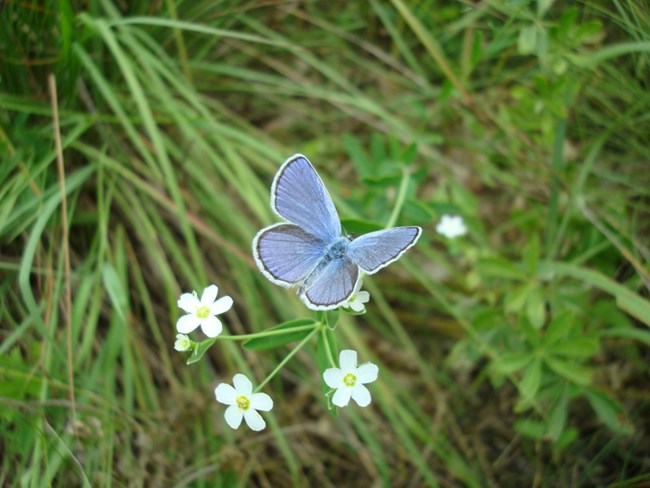Last updated: October 16, 2018
Article
Bison Bellows: Bison Bolster Endangered Blue Butterfly Recovery

Photo by Gregor Schuurman.
A tiny, rare blue butterfly with a one inch wing span is making a come-back in central Wisconsin, in part due to the largest land mammal in North America. Originally ranging across 12 states from Maine to Minnesota and at sites in the Canadian province of Ontario, the federally endangered Karner blue butterfly is thriving at the 9,150 acre Sandhill State Wildlife Area in central Wisconsin, where bison, a species brought back from the brink of extinction, play an important role in restoring the open oak savannah and prairie habitat necessary for Karner blue butterfly survival.
The Karner blue butterfly relies on lupine, a flowering plant in the pea family, for food and as a place to lay their eggs. Lupine plants have declined across the northern extent of their range due to loss of habitat and changes in habitat quality. Lupine plants and Karner blue butterflies flourish where a mix of shade and sun exists across the landscape, with broken or scattered tree canopies interspersed with open areas with grasses and forbs such as is found in oak savannah and prairie habitats.
But without periodic reductions of tree cover, shade-loving plants can outcompete and suppress lupine growth. While a variety of methods such as prescribed fire, mowing, and tree removal may be used to reduce tree cover and woody plants in order to create favorable conditions for lupine growth, bison naturally create and restore the open habitats that lupine -- and Karner blue butterflies -- need.
Research by Bob Hess, retired DNR conservation biologist, and his daughter Anna, also a DNR conservation biologist, and DNR wildlife managers revealed this link between habitat disturbances caused by American bison and improved habitat for the butterfly. "They found that the bison are having a real impact by keeping woody shrubs out of the area and causing minor soil disturbance," says Chelsea Gunther, the Department of Natural Resources conservation biologist coordinating surveys and Wisconsin's Karner Blue recovery program. The bison roll around on the ground, rub horns against the shrubs and trees, setting back growth and disturbing the soil. "It's making really great conditions for the Karner blues and I'm hopeful that these conditions continue to support Karner populations."
In 2015, 58,000 total butterflies were counted at the Sandhill Wildlife Area, a fourteenfold increase from the previous year's tally, accounting for nearly 80 percent of the statewide total of 74,000 in 2015. State conservation biologists hope their population surveys again find high numbers of the federally endangered species as the diminutive blue butterflies emerge from Wisconsin's savannas, barrens, prairies and sandy roadsides.
Will bison and rare butterflies prove a winning combination again this year? "The Sandhill site is looking promising again and I'm hopeful it is another good year there and at other central Wisconsin sites."
The Karner blue butterfly was listed in 1992 as a federally endangered species. Recovery efforts are underway in seven states including Indiana, Michigan, Minnesota, New Hampshire, New York, Ohio and Wisconsin. "We still have a ways to go to get to full recovery but there is obviously something good going on at Sandhill and at some of these other sites," Gunther says. "We're hopeful about what that means for Karner blue butterflies as well as the 50 other rare species that use the same kind of prairies, barrens and oak savannas they do," she says. After being saved from extinction over 100 years ago, bison are playing an important role in the restoration of another imperiled species, and perhaps the Karner blue butterfly will play a role in saving another species from extinction in the future as well.
*Adapted from a Wisconsin Department of Natural Resources press release.
